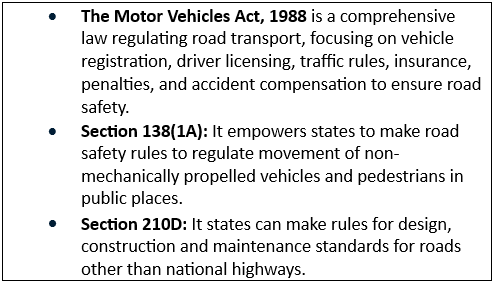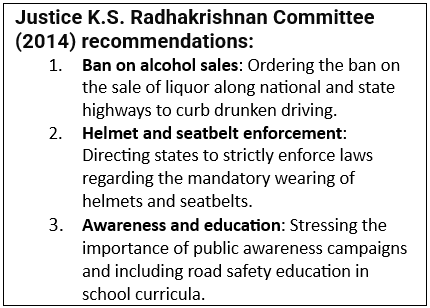Syllabus:
GS-2: Government policies and interventions for development in various sectors and issues arising out of their design and implementation.
GS-3: Infrastructure: Energy, Ports, Roads, Airports, Railways etc.
Context: Recently, the Supreme Court directed all States and Union Territories to frame comprehensive road safety rules within six months.
More on the News

• The rules should be implemented with a proper mechanism to regulate the movement of non-motorised vehicles and pedestrians in public spaces.
• The Supreme Court directed to frame such rules under Sections 138 (1A) and 210D of the Motor Vehicles Act, 1988.
Road Safety Scenario
• The number of crashes increased by 4.2% in 2023 as compared to 2022.
• Over 35,000 pedestrians lost their lives in road accidents in 2023, accounting for more than 20% of all road fatalities.
• More than 54,000 two-wheeler riders and passengers died.
• Road accidents cause India an economic loss of about 3% of its GDP every year.
• In India, daily on an average of 474 people die in road accidents which translating to nearly one death every three minutes.
Factors Behind High Road Accident Rates
• Infrastructure Deficiencies: Poor road design, including potholes, lack of adequate foot overbridges, underpasses, and poorly maintained roads, contribute significantly to accident risks.
• Rising Vehicle Numbers and Congestion: Rapid expansion of vehicles without adequate regulation or road safety adaptation increases accident likelihood.
• Inadequate Enforcement: Weak enforcement of traffic laws and low public adherence to safety regulations exacerbate the problem despite awareness campaigns.
• Human Error and Behaviour: Reckless driving, over-speeding, non-use of helmets and seat belts, driving without valid licenses, and traffic rule violations are primary contributors to road accidents
Way Forward
• Constitutional obligation: All road safety efforts should be based on the constitutional principle that the right to safe travel is part of the right to life guaranteed under Article 21 of the Constitution (Parmanand Katara v/s Union of India ,1989)

• Enhancing Road Infrastructure: Identifying and rectifying accident-prone ‘black spots,’ improving road design with pedestrian crossings, foot overbridges, and better lighting, and ensuring maintenance to minimize hazards.
• Setting up Robust Institutional Mechanisms: Constituting and adequately staffing a National Road Safety Board for coordination and policy oversight; establishing state and district road safety bodies; and creating a National Road Safety Fund for financing.
• Improving Vehicle Safety Standards: Mandating modern safety features such as airbags, ABS, crash tests, and speed limiters; enforcing strict vehicle fitness norms; and encouraging adoption of electric and safer vehicles.
• Data-Driven Policy and Continuous Monitoring: Developing an integrated crash data system, regular independent safety audits, and public dashboards for transparency and accountability in road safety efforts.

